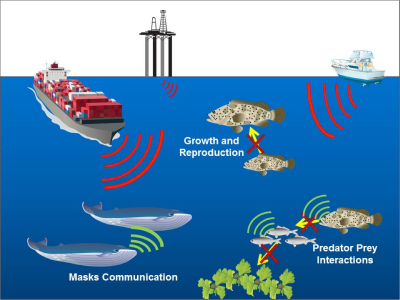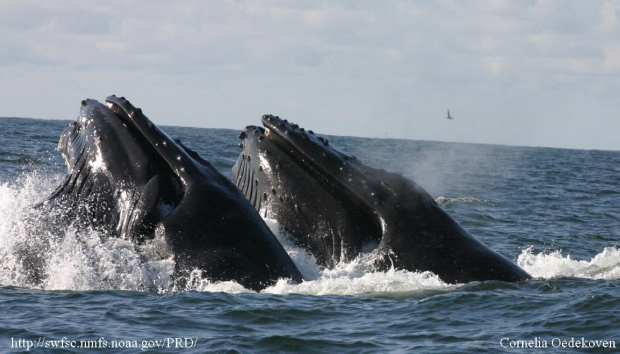Resource Issues: Acoustic (Noise) Impacts
Noise in the Ocean
 |
| Acoustic sources and impacts on marine life (IAN :Integration & Application Network—University of Maryland) |
This issue is important for the five West Coast Sanctuaries, including Monterey Bay National Marine Sanctuary (MBNMS) since the West Coast of North America is one of the busiest container-shipping routes in the world, and the Port of Oakland in San Francisco Bay is the 5th largest container port in the United States. In addition, the West Coast has a highly dense and growing human population and many recreational, military, development, and research activities taking place.
Noise Impacts
Most marine animals including marine mammals, turtles, fish, and invertebrates rely on sound for their survival. Research suggests that anthropogenic noise may alter their behavior, resulting in lower chances of survival and reproduction for individual animals. Noise can lead to long term effects on individuals and populations because there are reduced opportunities for hearing sounds used for navigation, finding food, finding mates, avoiding predators, and communicating, such as between mothers and offspring and other group dynamics. In addition, increased background noise and acute sound sources can cause physical injury in the form of temporary or permanent hearing loss or tissue damage.
Marine wildlife responses to human-induced noise vary depending on acoustic frequency, decibel level, distance of the noise source, and species-specific sensitivity factors for the exposed animals, including hearing sensitivity and context of noise exposure. Marine mammals have been observed deviating from their migration paths to avoid noise, and interrupting their communications in response to elevated noise levels. For example, introduced noise sources may displace small, discrete populations of harbor porpoise (2.1M PDF) from their primary habitat because of their sensitivity to anthropogenic noise.
Ships produce low-frequency noise that overlaps with the frequency that large baleen whales use to communicate. Ship’s low-frequency noise has the potential to travel many hundreds of kilometers and even in deep water environments. With a hundred thousand vessels (1.6M PDF) navigating the marine environment, the ocean has become a generally noisier place for marine animals.
Concern about the cumulative impacts of noise from a variety of sources has grown as the ocean has become noisier in the past half-century (762K PDF). Ocean acidification from climate change has also been predicted to have implications for ocean acoustics by allowing low frequency sound to travel farther. Long-term cumulative impacts are uncertain and may range from minimal damage associated with minor behavioral changes to larger impacts such as chronic physiological stress, behavioral changes with significant population consequences, and permanent physical damage to hearing structures. With increased human activities around the globe, this issue is expected to continue to increase in the future.
* Credit: Dieter Tracey, Christine Thurber, Tracey Saxby, Diana Kleine, Integration and Application Network, University of Maryland Center for Environmental Science
